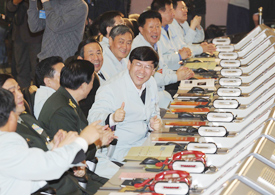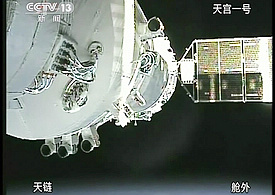|
 |
 |
|
JOB WELL DONE: Staff at the Beijing Aerospace Flight Control Center celebrate with each other after the successful docking of Shenzhou 8 with Tiangong-1 in the early morning on November 3 (XIE HUANCHI) |
KISSING EACH OTHER: A video grab taken from the China Central Television on November 3 shows the Shenzhou 8 spacecraft docking with the Tiangong-1 space lab module (XINHUA) |
At 1:36 a.m. on November 3, nearly two days after it was launched, the unmanned spacecraft Shenzhou 8 docked with space lab module Tiangong-1, or Heavenly Palace-1. The docking represents another significant milestone for China's space program.
Shenzhou 8 was carried into space by a modified Long March-2F rocket, which took off from the Jiuquan Satellite Launch Center in northwest China's Gansu Province at 5:58 a.m. on November 1. The Tiangong-1 space module was sent into space on September 29.
The success of the docking procedure makes China the third country in the world, after the United States and Russia, to master the technique. The mastery of space docking technology takes the country one step closer to establishing its own permanent space station by 2020.
"China is now equipped with the basic technology and capacity required for the construction of a space station," said Zhou Jianping, chief designer of China's manned space program.
"This will make it possible for China to carry out space exploration on a larger scale," he said.
"The capability increases China's ability to act independently in space, as well as its ability to cooperate with others," said Gregory Kulacki, senior analyst and China project manager at the global security program of the Union of Concerned Scientists, a nonprofit scientific advocacy group based in the United States.
"China's pursuit of an original solution to space docking could lead to innovations or experiences other space-faring nations may find useful," Kulacki said.
Making preparations
While the docking itself was completed in a matter of hours the planning and preparation for the mission involved over a decade of research.
Space docking technology is considered one of the most advanced proficiencies required for space exploration as it requires the precise handling of two high-speed spacecraft that must meet and link up in space.
The world's first space docking was achieved in 1966, when the manned U.S. spacecraft Gemini 8 docked with an unmanned Agena Target Vehicle.
Forty-five years later, the maneuver remains a technological challenge. Many of mankind's 300-plus space-docking attempts have been met with difficulties or resulted in failure.
"To connect two vehicles traveling at 7.8 km per second in orbit, with a margin of error of no more than 20 cm, is really like 'finding a needle in a haystack,'" Zhou said.
"In order to guarantee the smooth operation of the mission, nearly 100 contingency plans had been prepared to address problems that may occur during the mission," said Wu Ping, spokeswoman for China's manned space program.
| 